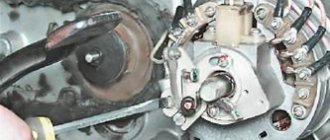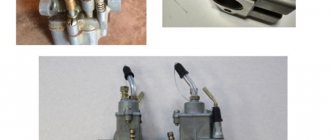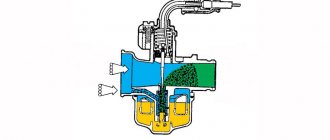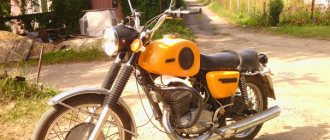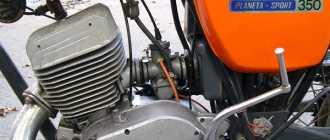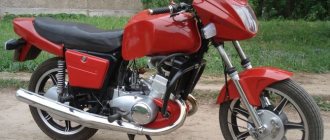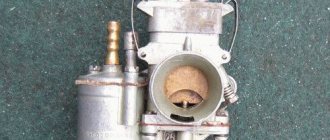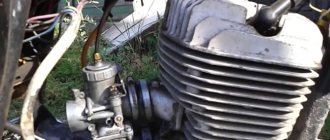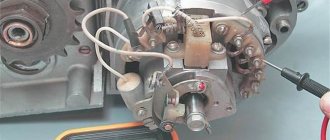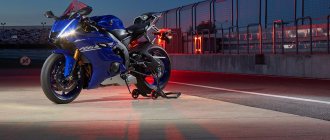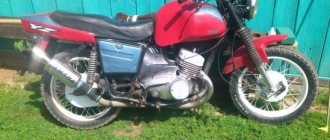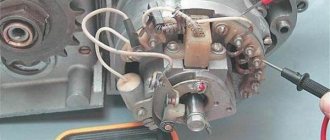Izh Jupiter is a popular Soviet motorcycle that is great for riding on almost any road surface . Among the obvious advantages of the model are compact dimensions, good maneuverability and relatively low fuel consumption.
If you pay attention to modern bikes of this type, then it’s also worth adding good speed and dynamics.
Main advantages
Motorcycles IZH Jupiter -5 were quite simple in design and did not require large maintenance costs. Today there are many who want to criticize this technique without regard to the times, but the model was in great demand among the population. She is not forgotten even now. On the secondary market only, on Avito websites, more than 2,000 units of equipment are offered for sale every day. The main reasons for its popularity are:
- Maintainability and simplicity of design.
- The presence of a semi-automatic clutch.
- Smooth ride, comfortable movement.
- Can be used with or without a side trailer.
- Good car dynamics without a side trailer.
- Durable welded tubular frame.
- Reliable and simple gearbox.
- Powerful alternator, good light.
- Confident engine starting in any weather conditions.
This is not an exhaustive list of the outstanding qualities of the machine.
The motorcycle has the highest level of maintainability. The shortage of spare parts of that time has given way to their abundance today. Any components can be purchased through online stores or in markets at affordable prices. With a small set of tools, a motorcycle of the simplest design can easily be rebuilt on the road. Replacing parts of the cylinder-piston group can be done without any problems directly in the field. More complex repairs involving removal and complete disassembly of the engine are possible in a garage without the involvement of large specialists or special tools.
The motorcycle is equipped with a semi-automatic clutch, which greatly facilitates the driver’s work. Gear shifting is possible without squeezing the clutch lever on the steering wheel. The clutch release mechanism is activated automatically when you press the gear shift foot. Before pressing the foot, it is advisable to release the gas - the switching will occur smoothly, without jerking the transmission. No other domestic motorcycle has such a system.
The machine is characterized by a smooth ride in single mode and with a side trailer. Riding a well-maintained motorcycle is a pleasure. The driver's position is comfortable and ergonomic. The passenger in the side trailer feels comfortable, protected from the flow of oncoming air and dust by a high transparent plastic reflector and a soft, durable awning made of leatherette. The trailer wheel has a spring-hydraulic shock absorber, which effectively absorbs uneven road surfaces.
A motorcycle with the index Izh Jupiter-5K-01 can be used with or without a side trailer. Operation of a motorcycle with a trailer is possible only if there is a corresponding mark in the technical passport when registering with the traffic police. When installing a trailer, the final drive gear ratio is changed by installing a smaller diameter drive sprocket with 16 teeth. At the same time, the engine traction force increases significantly due to an increase in the number of crankshaft revolutions. A 19-tooth drive sprocket is installed on a single motorcycle, increasing the speed capabilities of the motorcycle.
Without a side trailer, the machine has good dynamic capabilities. The two-cylinder engine quickly picks up speed and is capable of accelerating the car from a parking lot to 100 km/h in 12 seconds. This figure is 0.5-1.0 seconds better than that of the most advanced car at that time, the VAZ-2109, or the popular imported Java-350 motorcycle.
The motorcycle is assembled on a durable tubular frame, which is simply impossible to damage if used correctly. The side trailer has its own, no less durable frame, made of thick-walled steel pipes.
The gearbox is assembled in the same housing with the engine and has its own crankcase compartment. The unit is powerful, reliable, always working without problems throughout the entire service life of the motorcycle. There is an inspection hatch on the side cover of the clutch drive mechanism to check the oil level in the clutch housing and gearbox.
Electrical equipment operates from a powerful modern 12 V alternating current generator. Alternating current is converted to direct current by a diode bridge. All old problems associated with the operation of 6-volt DC generators installed on previous machines have been eliminated. The electrical system has become significantly more reliable. The headlight has halogen optics, which produces a fairly powerful stream of light.
The engine starts reliably at any time of the year due to the installation of an emergency start system that supports starting with a weakly charged battery.
Modifications
The Izh Jupiter motorcycle came to the market in three modifications:
- standard. It came without a side trailer, at the same time, there were mounts for the stroller;
- tourist. The vehicle was equipped with a sidecar, as well as an additional spare tire with increased lugs. Marked as 5T;
- lux (5L). Without side trailer and attachments to it. On the other hand, there was a compact fairing, a pair of knee roll bars, and a towed rack.
Design
The motorcycle retained the crew part of the Izh-56 motorcycle, but had a completely new engine - a two-cylinder, two-stroke, with a vertical transverse in-line arrangement of cylinders, air-cooled with a return-loop double-jet purge, with the preparation of the working mixture in the carburetor and its ignition in the cylinder from an electric sparks. The carburetor is closed with special casings (with a metal valve for access during start-up), the air filter is a contact oil filter. The parts of the connecting rod and piston group (piston, connecting rod, piston rings, piston pin, retaining rings, bearing rollers of the lower end of the connecting rod) are unified with the corresponding parts of the K-175 motorcycle engine.
The two-arm foot shift pedal and kickstart pedal are located on the left side of the gearbox housing. Izh-Jupiter, like all subsequent two-cylinder models, was equipped with an automatic clutch release mechanism.
The speedometer drive, unlike the Izh-56, is from the front wheel.
The front sprung mud shield is attached on a cast bracket to the lower bridge of the front fork, which eliminates the possibility of it becoming clogged with dirt.
Modernization
“Izh Jupiter” served as the beginning of a whole series of two-cylinder motorcycles:
- "Izh Jupiter-2" (1965-1971) - engine power 19 hp. at 4900 rpm
- “Izh Jupiter-3” (1971-1977) - power increased by almost 40 percent compared to its predecessor (25 hp at 5,700 rpm). The model was awarded the USSR State Quality Mark.
- "Izh Jupiter-3-01" (1977-1980) - engine power increased to 27 hp.
- "Izh Jupiter-3-02" (1979-1981)
- "Izh Jupiter-4" (1982-1985) - engine power increased to 28 hp. at 6,200 rpm, torque up to 3.58 kgf m, 12-volt electrical equipment, new lighting equipment.
- “Izh Jupiter-5” (IZH 6.113; IZH 6.114) (1985-1988) - engine power reduced to 24 hp. at 4800-5600 rpm, but the torque characteristics in the mid-speed range are improved. An “emergency start” button has appeared, which closes the generator excitation winding to ground, bypassing the voltage regulator, when starting with a dead battery.
- “IZH Jupiter-5-01” (IZH 6.113-01; IZH 6.114-01) (since 1988) - the motorcycle received a completely new appearance, unified with IZH Planet 5, released in 1987. The shape of elements such as the fuel tank, tool box lids, seat, and dashboard has been changed. Two cooling fins were added to the engine cylinders, nine instead of seven, the front part of each fin was bent towards the cooling air flow. A wide motor chain was installed, as a result of which the teeth of the motor sprocket and large clutch drum were changed.
- “Izh Jupiter-5-03” (Izh 6.113-03; IZh 6.114-03) (since 1993) - the model is equipped with a liquid-cooled engine IZH-Yu5 Sb. 1-08. Fuel consumption is reduced by 1.5-2 liters, noise level is reduced by 30%, engine power is 25 hp.
Features of tuning models
It is worth saying that the Jupiter 5 motorcycle lends itself perfectly to modernization, which is what domestic craftsmen use. If you want to improve the parameters of your two-wheeled horse, then, first of all, you should:
- replace ignition contacts on electronics;
- install a tachometer;
- add a leg on the side instead of mounting the power unit;
- install samples in the exhaust, which will help change the sound of the engine;
- add a couple of extra carburetors (it is worth noting that this will not only increase the power of the Izh Jupiter 5 motorcycle, but will also increase fuel consumption);
- update the turn signals and mirrors, remove the trunk. This will add additional attractiveness and charm to the model.
You may also be interested in: The main types of motorcycles: choosing an “iron horse”
Motorcycle appearance
When the Jupiter 5 model came out, its design was already well-known, because it was inherited from the Jupiter 4 motorcycle. But soon the Izh Planet 5 appeared on sale, and the developers saw that they could borrow several design elements.
The first modification had a square-shaped dashboard, which consisted of several indicators, an ignition switch and a speedometer. But soon its appearance was redesigned, and instead of one dashboard there were two. On the first part they placed warning lamps, and on the second part they decided to put a speedometer.
The design of the fuel tank has also been slightly redesigned, with rubber pads on the knees and the shape of the tank itself has become slightly different. Accordingly, in the new modifications of the Moto Izh Jupiter 5, it received a different, longer seat that ended at the brake light. This innovation is still considered stylish and modern.
During the Soviet era, creating high-quality and impressive equipment was as easy as shelling pears, because the country had all the resources for this. Thus, the Izhevsk plant produced a motorcycle that is capable of carrying a load of up to 500 kg. Just imagine what could be carried on this transport!
Being a workhorse, the motorcycle had a fairly sporty appearance and excellent top speed. With a power of 25 hp. the motorcycle could accelerate to 120 km/h. This is a completely standard indicator, because another representative of the Dnepr could give a maximum speed of 110 km/h. In severe frosts down to 30 degrees, the unit started up perfectly, which cannot be said about the current new products. Unfortunately, many owners complain of frequent engine breakdowns due to their long lifespan.
A short summary
Looking at the photo of Izh Jupiter 5, you can feel nostalgic - after all, this is exactly the vehicle from childhood and adolescence that many of us drove along rural roads and small streets . At the same time, Izh Jupiter 6 is still alive today.
Perhaps the basic technical parameters here are not very high, but thanks to countless modifications and modernization, this Soviet motorcycle can compete on the road with more modern vehicles.
Video review of the Soviet motorcycle IZH Jupiter 5:
Description of design
So, this motorcycle was first shown in 1971.
It was produced in two versions - “IZH Jupiter 3” and “IZH Jupiter 3K”.
They differed in that the “3K” was additionally equipped with a side stroller, but it had the ability to be detached from the motorcycle.
At that time, Jupiter 3 had a modern appearance and was well made, although it was based on its predecessor. All elements of the motorcycle were attached to a tubular frame.
To increase comfort, the front suspension travel was increased and the rear shock absorbers were made softer.
They changed the shape of the tank, it stopped being teardrop-shaped. But the headlight did not change; its housing continued to house the speedometer, ignition switch and warning lamps.
The seat is undivided, double. A rear fender with a brake light, turn signals and a license plate placed on it was attached to the seat body from below.
Turn signals on the IZH Jupiter family began to be installed precisely from the third model.
There were glove compartments under the seat on both sides of the motorcycle, the left one was intended for installing the battery, and the right one was for storing keys.
The engine was located under the tank, which ensured that fuel flowed into the carburetor by gravity. To prevent spontaneous leakage of gasoline, a tap was placed on the tank.
The cylinders had an in-line arrangement. When designing a new engine for this motorcycle, the position of the cylinder fins was revised, which subsequently ensured better cooling.
One elbow came out of each of the cylinders, to which two exhaust pipes were screwed, mounted on the sides of the motorcycle under the footpegs.
The power system consisted of a single carburetor located behind the cylinders and connected to them by a pipe with a double outlet. In the base, the motorcycle came with protective covers covering the carburetor.
By reworking the engine, the designers managed to increase its power by 6 hp, which affected the speed; it increased to 120 km/h.
The gearbox was made integral with the engine. Torque was transmitted via a multi-plate clutch. The drive to the rear wheel was carried out by a chain.
The rear drive sprocket was housed in an aluminum housing.
The front suspension was made in the form of a telescopic fork, and the rear suspension was a pendulum with two shock absorbers.
The brakes on both wheels are mechanically driven drums.
At one time, this motorcycle was awarded the State Quality Mark because it was reliable, easy to repair, and easy to start, compared to the IZH Planet.
Its only weak point was the contact ignition system. It practically consisted of two contact systems, one for each cylinder.
This affected the convenience of installing the ignition; it was difficult to achieve the same advance angle on the cylinders.
I made my dad happy: he took the old Yamaha and turned it into the Planet-Sport IZH!
“Planet-Sport” is one of the best Soviet motorcycles, with which our industry reached its zenith. A bright and original design, decent “figures” and imported components allowed it to compete on equal terms with “foreign cars” even in foreign markets - an unthinkable success by today’s standards.
This text was written for the September issue of MOTO magazine, which was not published as well as the October and, apparently, November issue. Having survived the “damned 90s”, the rise from the knees of the 00s and the stability of the early 10s, the current management of the magazine, judging by the delay, could not stand it.
Desk work is not for me, so let this note come out here.
Thanks to Vladimir Tetyukhin for the wonderful photographs.
Today, a well-restored PS is one of the few domestic motorcycles that are truly valuable to fans, and the price tags are rising every year. Demand also drives prices for spare parts, which are increasingly being labeled with a dozen labels - “rarity”, “shortage”, “early” and “Japanese”. For the red corner in the garage - yes, but no more.
For a Euryday motorcycle, the Japanese necroclassic, the face of which is the Yamaha SR400, is much better suited. Appearing in 1978, it can be considered the same age as Planet-Sport, which debuted in 1973, and much more successful - it is still sold in some markets. Why not the basis for restomod?
The union of the two grandmothers in this loving ecstasy did not seem a problem in theory, but in reality it took a long time. The main problem is the PS tank, which refused to sit on the thick pipe of the Yamaha frame, which acts as an oil tank. A friend came to the rescue, donating the lower part of his old SR tank and welding the top of the PS to it.
The fenders and lighting equipment fit without any problems, but the service had to tinker with the saddle and fork “flags”, welding the brackets and turning out the adapters. Stickers were attached to the early PSs, but I preferred the later heavy metal nameplates; such decorations look more convincing.
The most expensive acquisition was an early speedometer with a “reverse” orange arrow; they managed to “make friends” with the Yamaha speedometer drive. But the remote controls and levers remained original, Japanese; all this old-fashioned fittings fit very organically into the look of the restomod.
The only thing that gives it away as a replica is the exhaust located on the “wrong” side and the large 4-stroke engine. It hurts not only the eyes, but also the nose - there are no sweet notes of refined sugar and condensed milk in the exhaust blend, so even the blind can call this motorcycle fake.
A little later, a video about this motorcycle will appear on the channel of the Motoexpert magazine:
https://www.youtube.com/user/motoexpertmagazine
Subscribe to my blog on Yandex.Zen, there’s even more interesting stuff there:
zen.yandex.ru/fedotov_moto
Engine diagnostics and repair
It is sometimes impossible to find the cause of a breakdown after one visual inspection. In some cases, complete disassembly of the IZH Jupiter 5 engine is necessary. But if you find out the reason, you can quickly solve the problem yourself. Here are examples of main faults and repair recommendations:
- If your kickstarter turns on the crankshaft, you must:
- Tighten the fasteners more tightly, and in case of severe damage, replace the kickstarter shaft and lever. This usually happens after the IZ Jupiter 5 engine has been boosted.
- If the oil is selected incorrectly, especially if it is very viscous in winter, it is necessary to select a more correct temperature regime.
- If the trigger spring is weakened, it must be replaced.
- If no fuel gets into the carburetor, you should clean it in a solvent, and also blow out the channels and fuel supply hose with pressurized air.
- If there is no spark in the combustion chamber, replace the spark plug or clean it.
- When the throttle valve sticks, it is necessary to adjust its drive and clean the carburetor.
- If the engine is unstable or does not start the first time, it is worth checking:
- Fuel supply system. The fuel mixture may be oversaturated with air. The solution to this problem is to replace the air filters and install new gaskets.
- Is the capacitor OK? If strong sparking occurs between the contacts, the capacitor must be replaced.
- Severe wear or burning of the spark plug. In most cases, it is the spark plugs that cause poor starting and uneven engine operation.
These are the main problems that may occur during operation. How to disassemble the IZ Jupiter 5 engine is written in detail in the maintenance book issued upon purchase. Everything stated in it is written in clear text, with diagrams and detailed instructions.
Not only the repair of a Soviet unit is within the power of any owner.
There are many questions about how to assemble the IZH Jupiter 5 engine yourself, modifying it. For example, installing a more reliable carburetor or a more stylish and loud muffler can be done quickly enough without significant financial investments.
Tuning an IZH Jupiter engine with your own hands is possible if you have enough time and enthusiasm. You just need to be persistent.
The motorcycle has a favorable ratio of cost, build quality and maintenance requirements. An ideal option for people with a small budget and those who want to get universal equipment. However, frequent breakdowns will take a lot of time. It's worth being prepared for this, since some bikes can be 40-50 years old.
Planet 5
It was also produced by the Izhevsk Machine-Building Plant from 1987 to 2008.
Main advantages:
- The engine is “high-torque” Planet 5 is compared to a tractor, it has such good engine traction.
- No ignition problems.
- Not high fuel consumption.
- Compared to Jupiter 5, repairs are even easier.
Characteristics:
- Weight - 158-165 kg
- Engine – two-stroke single-cylinder, 22 hp.
- Cooling is air.
- The maximum speed is 120 km/h.
- Fuel consumption is 5-6 liters.
Main disadvantages:
- Starter kickback to the leg. There were cases when a foot was broken.
- Unpleasant vibration. It's like sitting on a massager.
- Sound when working. It looks like it's about to fall apart.
Now both motorcycles can be bought on the market, the cost ranges from 5 to 50 thousand rubles. Both models were produced in limited quantities with water cooling; they are now more difficult to obtain. Liquid cooling reduces fuel consumption and reduces noise levels.
Hi all! Suddenly, I had to drive another Jupiter-4 into the garage. The history of the motorcycle is quite sad, but so that it does not completely sink into oblivion, we decided to take it for ourselves. Having given myself one more task for the winter - to restore. Everyone is welcome! So, pour yourself some tea/coffee, because the history of all this madness is long. Go! It all started in the spring, when my friend was inspired to buy Jupiter-4 for himself on the documents. The idea was to pass the license in the summer, buy a motorcycle and restore it, so that later you can ride without any problems. I found an advertisement, just in our village, for the sale of Jupiter-4 on documents. In the description, the motorcycle was simply perfect, but when we arrived... More precisely, not so, before going to look at the motorcycle - fate had already given a sign that it would not be necessary... The sign it was simple - 2 out of 3 Jupiters simply did not start, although they were driving literally 5 minutes ago and there were no signs of trouble. For some reason, only my Jupiter wanted to go after another four, of which there were already four on the street. It's good that the garages were a 15-minute walk away. But I drove mine once it started up. We arrived, and there... The description says it’s an ideal motorcycle, but in reality it’s...
According to the seller, the motorcycle is his relative. It stood for a long time, but I filled it with fresh gasoline. (He only filled up with gasoline; this man seemed to have forgotten about oil). When trying to start this miracle, the kick starter fell off and the man, without any complexes, went for a large hammer and simply hammered it onto the shaft, I looked at it from the side with eyes of 5 rubles and thought, it’s good that I’m not buying this. As a result, the price was reduced, the documents were taken and driven home. As I followed them, I saw that there was little smoke coming from the chimneys. Already at home, after draining the gasoline, we realized that there was no oil. Well, with the replenishment. Jupiter Club 4 has been replenished. And as luck would have it, after the replenishment, the rest of the Jupiters started up as if nothing had happened.
What we see is a typical workhorse. We don’t know what or how much he transported, but it’s clear that grandfather went not only for bread. Well, what to do, what we fought for, that’s what we ran into))) The most important thing for us was the documents and the fact that he was traveling and everything in him worked. Well, almost everything...
After some time, a friend successfully registered it in his name. After driving around the fields for a month, I decided it was time to start recovery. We began disassembling the motorcycle to determine what to look for in terms of spare parts. Having learned that he was starting to disassemble, we went to help. The process began, and then... Horror. Everything is rusty and literally held together by snot.
Electrical tape, twists, home-made fasteners and headlights. Almost everything is crumpled and eventually killed. Well, I think we got it.
Here my grandfather already invented something for... Probably so that the saddle would not hit the frame. The frame itself is terrible. Most of the bolts did not unscrew, but simply came off.
I don't even know if the mileage is real. As for the condition of the motorcycle - quite!
They removed all the ugly wiring, which was all twisted and insulating tape.
Well, this is already a standard. My knees were siphoning, but no one pulled them up. Oil and dirt are a great combination and just another nightmare for a metal brush.
This is already... How should I put it, the national idea - there is nothing permanent, except temporary, tied with wire or blue tape.
Drygatel. The cover was installed from Jupiter-5. This was a plus, here even the kick starter oil seal did not leak than on the four-wheel covers. Even when they installed a new oil seal, it still leaked!
And what we see here - well, everything is completely killed. And he did go! And he carried everything that was loaded into it. The shock absorbers were already beginning to bend from fatigue.
But this... This always infuriated me! This is when oil leaks from all the cracks in the engine except the kick starter oil seal. They don’t change it anymore, they just simply top it up. And all this flows through the engine and these... palipas begin to grow, removing it is, well, a pleasure. Apparently I didn’t have the right attitude towards technology, I drove - and to hell with it.
For some reason this picture came to mind when I assessed the condition of the motorcycle. It was as if someone had jumped on it in the same way, with a loaded stroller and another passenger in the back. It's strange how he stood it, but still.
What happened next? Then the fun began. A week later, a friend realized that the “light” of recovery had gone out and decided to sell this hardware. But who will buy a disassembled motorcycle from him, which can hardly be called such. Well... apparently there were no more fools than me, and I thought - I’ll take it, but even cheaper than it was bought. Just in the garage there are a lot of spare parts from fours, at least I can make a motorcycle and clear out the shelves. Well that's why he didn't think about it EARLIER! Now I need to re-register it in my name, but here everything is sorted out. At least I was smart enough and lazy enough not to start disassembling the engine. Damn, now I have to put it back together. And not just to assemble, but to make sure it gets to the MREO and back.
As a result, out of grief, I took 3 bottles of lemonade and we went to collect from what we had, albeit with a different lining for this poor fellow. In 2 hours they assembled it as it was, even a little better. A glimmer of hope appeared.
After two evenings of dancing with a tambourine, Jupiter came to life. As was customary, a friend began to wash the removed engine in a car wash and filled all the cylinders. Plus the ignition is rusty. They cast a spell, fortunately or unfortunately I don’t know, but the experience of reviving dead people helped us - and this motorcycle was no exception. Now he is at full speed ready to go for re-registration.
But why all this? I don’t know, I feel sorry for the technology. There are documents, there are spare parts, why not do it. This time I plan not to keep it for myself, but to sell it if possible. Someone wrote a long time ago, just on the bike post, to try to collect and sell. But really, I’ll try to collect it as for myself, but then give it to good hands. They often ask about selling my motorcycles, but I’m still not eager to get rid of them, but this is purely for experimentation. At the same time, there will be something to do in the winter.
The circumstances also turned out differently. Anyone who has read my posts probably remembers buying two Jupiter-4s, one of which had a mileage of 6000 km and was in fairly good condition. For those who don’t know, just in case - read for the complete picture - We bought Jupiters 4
Well, that orange Jupiter did not live up to expectations for the restoration of documents, so it will go entirely towards this project. The lining and chassis are still in excellent condition. But the engine, which we also hoped for, gave us an unpleasant surprise. I’ll tell you about this now too. One summer evening there was nothing to do, so we decided to disassemble the engine from the orange Jupiter and see what was there after 6000 km. The jammed cylinders made us a little afraid, but we decided to do it.
Stock up on coffee. There was a rather positive atmosphere: the mug wished “no fluff!”, the chocolate “inspiration” encouraged success, the flavoring drove away flying bloodsuckers (yes, we use the fan head from P5 for this - we got a little snickery). Let's go sort it out!
Huge dirt and missing neutral sensor. Tolerable.
The nominal pistons are rusty. Somehow the cylinders were removed. It’s as if they poured water in there on purpose! Interestingly, the upper piston ring has the original coating, as far as I remember, titanium nitride, like on liquid-cooled Jupiters. Okay, let's go.
Wow! It's time to drain the oil. 1.5 liters of liquid were drained, where 80% was water, 20% was oil. The level was visible on the clutch release disc. And he doesn’t look like a drowned man and the devil knows how it happened.
No comments are needed - this is a fiasco. This is how you can ruin an engine at 6000 km. Such dirt!
And here is the neutral sensor under the gear shift sector! Yes, the shift mechanism spring was broken and was somewhere in the same chaos.
When I saw the contents of the KShK, I almost fell... What the... At this point I finished disassembling. I put everything aside, what was still in good condition, and everything else into the ferrous metal. I’m not going to fix such a piece of dirt - I’m tired of it, you just have to clean it all out... and what’s the point, even the shafts here can’t be repaired. It's not meant to be. I don’t understand how this is possible! Ditch the practically new engine! My planet 5-01 has gone through almost the same amount of time since capitalization, and the condition is like new... I don’t know how people do this.
That's all that we managed to take good from the engine. After cleaning, it was clear that the gearbox was in almost perfect condition, as were the rest of the little things. All this will go into use when the time comes to repair the engine.
This year we are frankly unlucky with good engines, which is why such a pile of non-ferrous metal has accumulated. Here is something that really couldn’t work.
Now both poor fellows are in the same garage. One is waiting for us to go to registration, and the second is waiting for us to arrive from registration and start sorting everything out.
This time I decided to mess with the original fasteners and have them galvanized. I just want to assemble a motorcycle as close to factory condition as possible. With every new motorcycle bulkhead, some changes are made, now the fasteners.
On this note we can end the first part. A start! Whatever one may say, it’s still impossible to describe everything here at once. Therefore, in the second part I plan to disassemble both motorcycles, completely troubleshoot the components, disassemble the engine, paint and begin assembly. I think it will be interesting. Thank you all for your attention! See you again!
A start! Whatever one may say, it’s still impossible to describe everything here at once. Therefore, in the second part I plan to disassemble both motorcycles, completely troubleshoot the components, disassemble the engine, paint and begin assembly. I think it will be interesting. Thank you all for your attention! See you again!
Structural nuances
It is worth noting that the model from the designers of the Izhevsk Machine-Building Plant was at one time considered one of the most modern. The developers introduced a new body into the modification, modernized the engine and implemented the best developments in the field of creating two-cylinder “iron horses”.
Considering that a completely new anti-vibration system and a fundamentally different fuel tank configuration were mounted on the old frame, the bike in question became a real breakthrough in the segment of domestic two-wheeled motorized equipment. A more powerful multi-disc clutch can also be considered an advantage of the model.
The Izh Jupiter-4 vehicle, the characteristics of which are given above, has received an updated shock absorption system and electronic equipment. The last node is very similar to the analogue used in the legendary sports version “Planet-Sport”. It is from this variation that the battery and most other elements related to electrical equipment, including the generator and coil, were borrowed.
IZH-1 - the first motorcycle of the Izhevsk Motorcycle Plant (9 photos)
On December 4, 1928, the first samples of domestic motorcycles, named Izh-1, came out of pilot production in Izhevsk (now OJSC Izhevsk Motorcycles).
See all photos in the gallery
At the end of the 20s, the Avtodor council sent P.V. Mozharov on a business trip to foreign factories. From there he brought several German motorcycles of different brands, instruments and tools.
Petr Vladimirovich Mozharov
At the same time, Avtodor purchased 14 well-proven English and American motorcycles, gave them bench tests and tested them (the then famous tester S.I. Karzinkin was involved in this matter) in the 1st All-Union Motorcycle Rally in 1928.
Leningrad engineers with L-300 (far right - Mozharov)
Mozharov, who took part in it on a German Neander, pleased the riders and spectators with the words: “... a Soviet motorcycle has already been designed, suitable for riding on our roads. Now the Izhevsk plant has started assembling such machines, by spring the first three prototypes will be ready, which we will probably present for the next motorcycle rally, and then Ruzhpultrest will begin their mass production.”
Indeed, in the fall of the same year, several experimental motorcycles began to be designed and built in Izhevsk. However, not everything went smoothly, and for the start of the 2nd All-Union Motor Ride, only IZH-1 was prepared (I. Shchedrin’s team of mechanics completed training on September 17, 1929), IZH-2 and IZH-3, and two more “IZH-4” and “IZH-5” were getting ready, but they were hopelessly late for the start.
So they were sent on the run untested, with unadjusted carburetors... Nevertheless, all five successfully completed the 3,300-kilometer route and finished in Moscow.” IZH-1 and IZH-2 were almost identical, equipped with four-stroke, two-cylinder, V-shaped engines with a displacement of 1200 cm3, maximum power of 24 hp. With. at 3000 rpm.
Magneto ignition. The engine was located across the frame. The gearbox had three stages. Drive to the rear wheel is by cardan shaft. The wheel of the side trailer (sidecar) was also driven, so the cars walked confidently off-road; 23 liters of fuel in the gas tank was enough for 300 km, the maximum speed reached 65 km/h. The front fork is parallelogram.
The motorcycle is based on a stamped frame made of two solid trusses. The lower part of the frame also served as a muffler housing - this feature was characteristic of all five motorcycles of the first series. It was an impressive car in terms of weight and dimensions with a two-cylinder four-stroke V-twin engine with a displacement of 1200 cubic meters. cm and maximum power of 24 hp.
The engine crankshaft was located longitudinally, torque was transmitted to the rear wheel from a three-speed gearbox, mounted in a block with the engine and driveshaft. The machine was intended for operation with both passenger and cargo trailers. The power reserve ensured the ability to drive on the most difficult roads.
Characteristic:
Engine displacement is 1200 cm3. Number of power strokes – 4. Number of cylinders – 2. Number of gears – 3. Reverse gear – cardan shaft. The fork is parallelogram. Wheelbase, mm – 1400 Ground clearance, mm – 120. Weight without side trailer, kg – 300.
The vehicle was intended for operation with both passenger and cargo trailers. The power reserve ensured the ability to drive on the most difficult roads.
Technical characteristics of Izh Jupiter 5
In general, the characteristics of the Izh Jupiter 5 motorcycle corresponded to its time. But in the 2000s, when it continued to be produced, it could no longer compete with imported models. The Chinese had already flooded the market with budget, but still more modern models, and a flood of used motorcycles poured from Japan, Europe and the USA. The characteristics of the Izh Yu5 engine were not bad, but everything else was hopelessly outdated a couple of decades ago.
Engine
The technical characteristics of the engine are not amazing - two cylinders, 347 cubic meters. There is enough horsepower, as much as 24, torque - 34 Nm. Compared to the previous generation, the engine lost 4 hp, but gained torque, and there was also noticeably more thrust at the bottom, so in general the characteristics of the Izh Jupiter 5 became more balanced. But the engine remained two-stroke, and the gas tank must be filled with oil mixed with gasoline in a ratio of 1 to 25. But it can easily digest even AI-76, not to mention AI-80. The declared maximum speed is 125 km/h, and it can be achieved on Jupiter without a stroller. And if you look at the engine in cross-section, it turns out that it subtly resembles all the engines at once that were ever produced at the Izhevsk Motor Plant.
Transmission
Standard 4-speed transmission, where first gear is downshifted and all others are upshifted. It has never been reliable, but thanks to its high maintainability and availability of spare parts, Soviet motorcyclists quickly learned how to solve problems on their own. Some garage craftsmen even completely rebuilt the transmission, adding a fifth gear to the bike, but these were custom ones.
Chassis and brakes
The chassis was developed back in the 70s, if not earlier, and in Jupiter 5 it has remained virtually unchanged. A conventional steel frame with a telescopic fork in front and ancient shock absorbers a la “candle” in the rear, plus drum brakes on both wheels. The effectiveness of the suspension and braking system was mediocre even for its time, but they also had a significant advantage - endurance and maintainability. On modern motorcycles (except perhaps enduro), oil from the fork quickly begins to leak on rural dirt roads, and Izh Yu5, it seems, can ride without it at all. But we still do not recommend testing this in practice.
Electronics
The fifth generation Jupiter does not have the same electrical problems that the fourth had. In fact, this model is the same Jupiter 4, but with a number of corrected shortcomings, such as regular wiring problems. Gasoline consumption has also become lower thanks to a redesigned ignition. In general, the electrical circuit has changed slightly, but the weak points that regularly served as a source of headaches for owners have been removed.
Weight and dimensions
The dimensions of the bike can be called average, as well as its weight. How much does Izh Jupiter 5 weigh? By modern standards - quite a lot, about 160 kg, and this is only dry weight. But the motorcycle engine is located low, so the center of gravity is also shifted down. The relatively large weight is due to the fact that in the USSR they did not skimp on hardware, and plastic elements were practically not used. If something can be made from iron, it must be made from iron! That is why the weight of the Izh Jupiter 5 engine is about a quarter of its total mass, if we consider the specimen without a sidecar.
Controllability
This mastodon handles mediocrely, not least because of the ancient design, and with a stroller the handling becomes even worse. But the cradles for Izh Jupiter 5 were also produced separately, so if you don’t need it, you can always disconnect it. But don't forget about the weak brakes, which are not enough to effectively stop a massive bike. On the other hand, the Izh stroller is good because you can load a lot of spare parts and other goods into it when going on a long trip, since its volume allows this.
